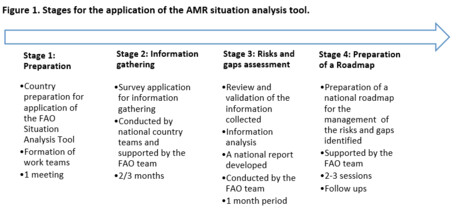FAO tool for a situation analysis of AMR risks in the food and agriculture sectors
Introduction
Countries have produced National Action Plans (NAPs) that outline strategies to combat and manage AMR, including components related to food and agriculture.
National authorities require detailed information on the AMR situation, enabling them to design, implement and manage appropriate strategies according to the country reality and needs for the development of NAPs.
In 2017, the first FAO activities on AMR for the Latin American and Caribbean region revealed a lack of related information from the food and agriculture sectors. To address this situation, the FAO Regional Office for Latin America and the Caribbean (FAO RLC) developed the “FAO Tool for a Situation Analysis of AMR risks in the Food and Agriculture Sectors”, under the One Health approach.
What is the FAO tool for a situation analysis of AMR risks in the food and agriculture sectors?
The objective of the FAO tool for a situation analysis of AMR risks in the food and agriculture sectors (hereafter “AMR situation analysis tool”) is to provide, at national level, a qualitative and systematic assessment of the risks and gaps of AMR from animal production systems (terrestrial and aquatic species), for animal health and human health, respectively.
The AMR situation analysis tool consists of three instruments:
- Survey for data collection;
- Methodological procedure for the analysis of information collected; and
- Instructions for the preparation of a national roadmap for the containment of AMR.
The roadmap includes guidance for prioritizing needs and sectoral actions consistent with the characteristics of the institutional systems in the countries and their NAPs.
The tool considers an AMR epidemiological model and guidelines for conducting a risk analysis of AMR (Codex Alimentarius and OIE guidelines), along with other cross-cutting factors.
Outputs
The results of the AMR situation analysis tool provide a picture of the current situation and guide decision-making for the containment of AMR under the One Health approach, considering the needs and resources of each country and their NAPs.
Application process:
The tool is applied in four stages of progressive development with the support of the FAO team (Figure 1). Each stage is guided by a FAO team and can be deployed online.
click to enlarge
The tool is available in Spanish and English and has been implemented in ten countries from the LAC region. Two countries in Africa also piloted the tool.
As a result of the application of the AMR situation analysis tool, the countries:
- Collected data that is disaggregated or difficult to access, identifying necessary information.
- Evaluated the factors contained in the AMR epidemiological pathways, associating mitigation measures and cross-cutting factors involved in the generation and dissemination of AMR from the animal production chain.
- Identified the weakest factors to address the containment of AMR, allowing countries to identify risks and gaps, facilitating the formulation of a roadmap and assisting in the formulation/implementation of the NAPs.
- Increased the intersectoral participation between different stakeholders (public and private), enhanced the understanding and awareness of risks derived from AMR, and emphasized shared responsibility to address AMR.

